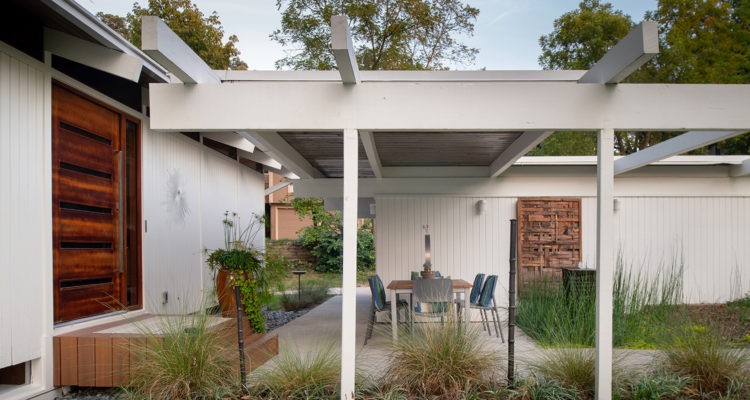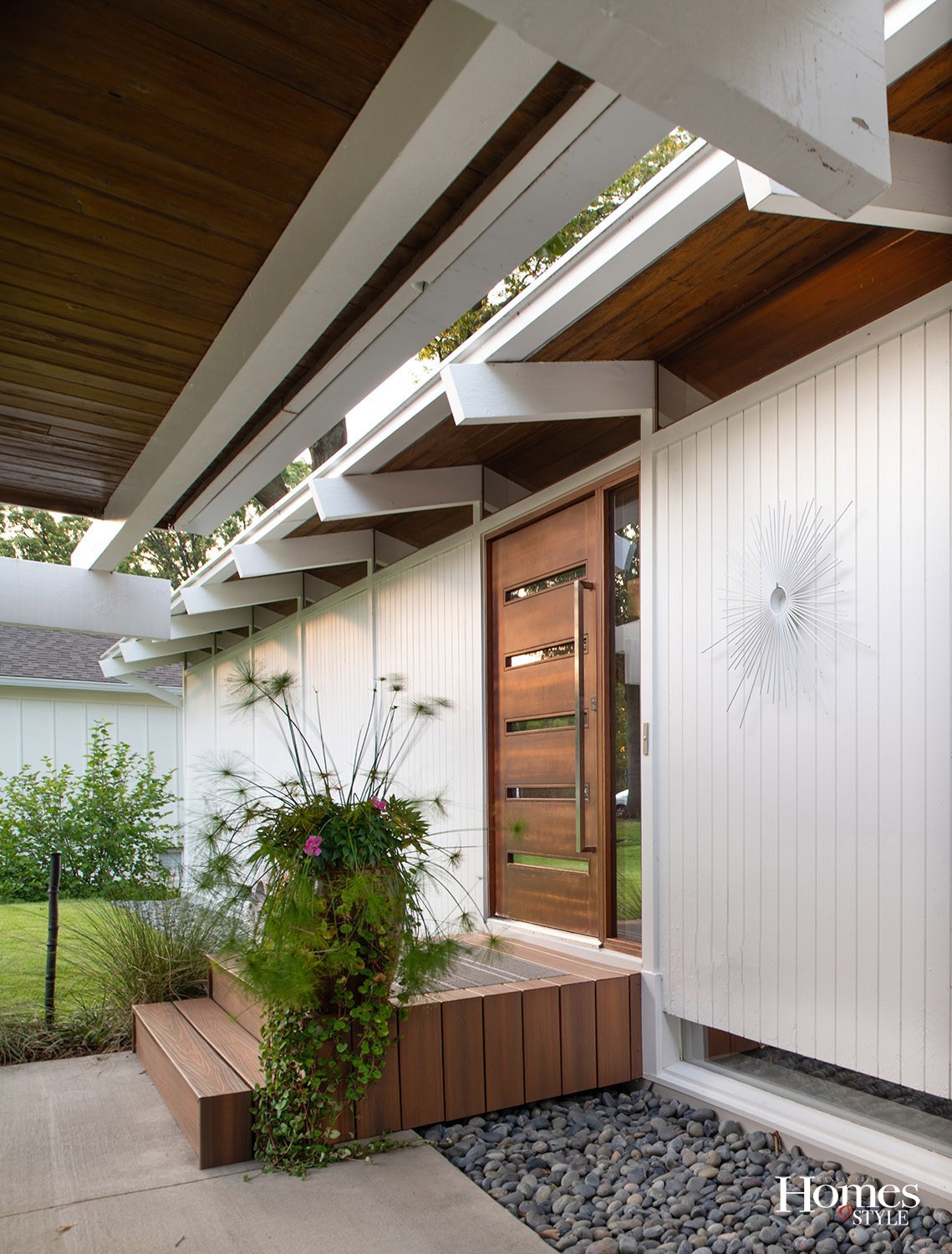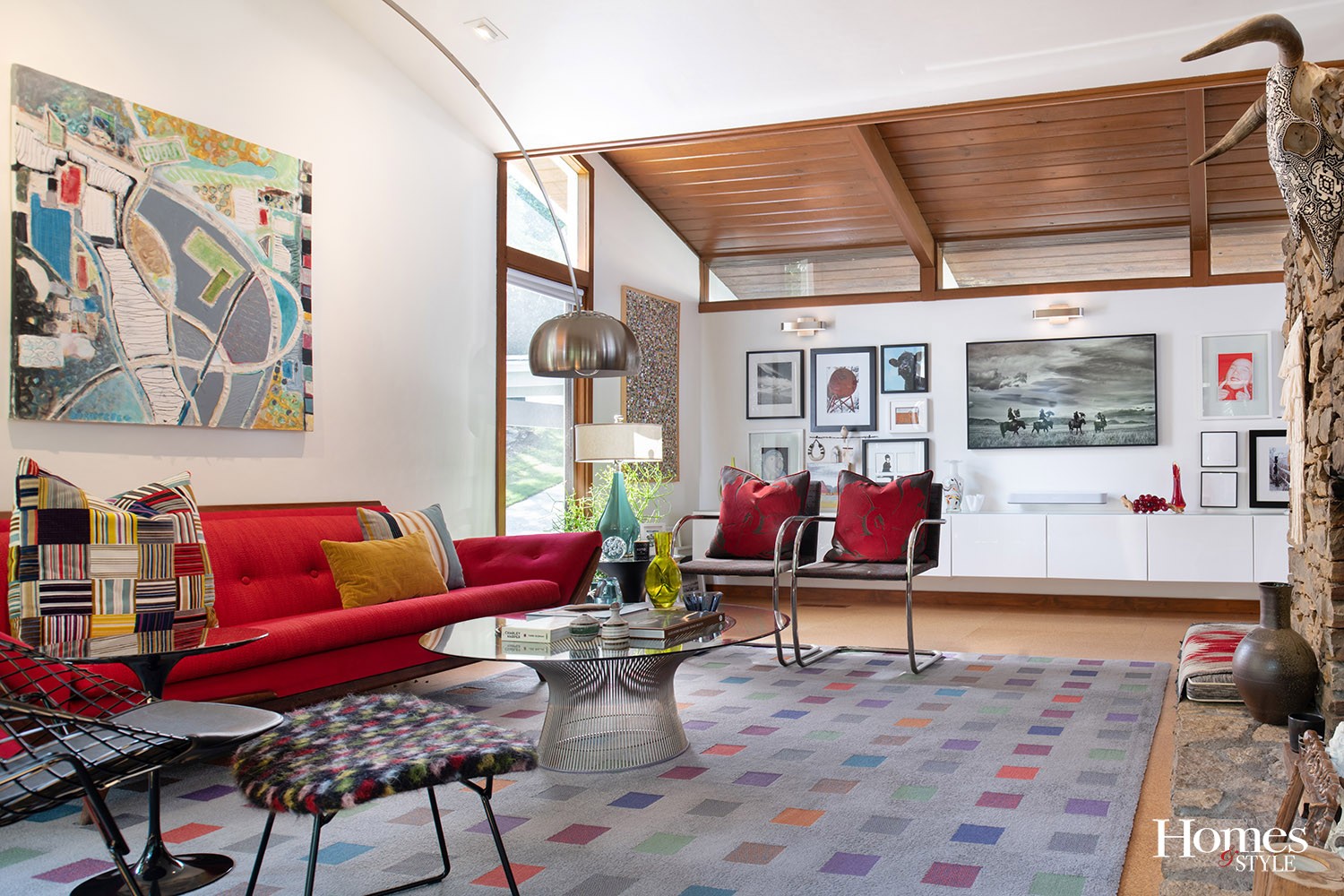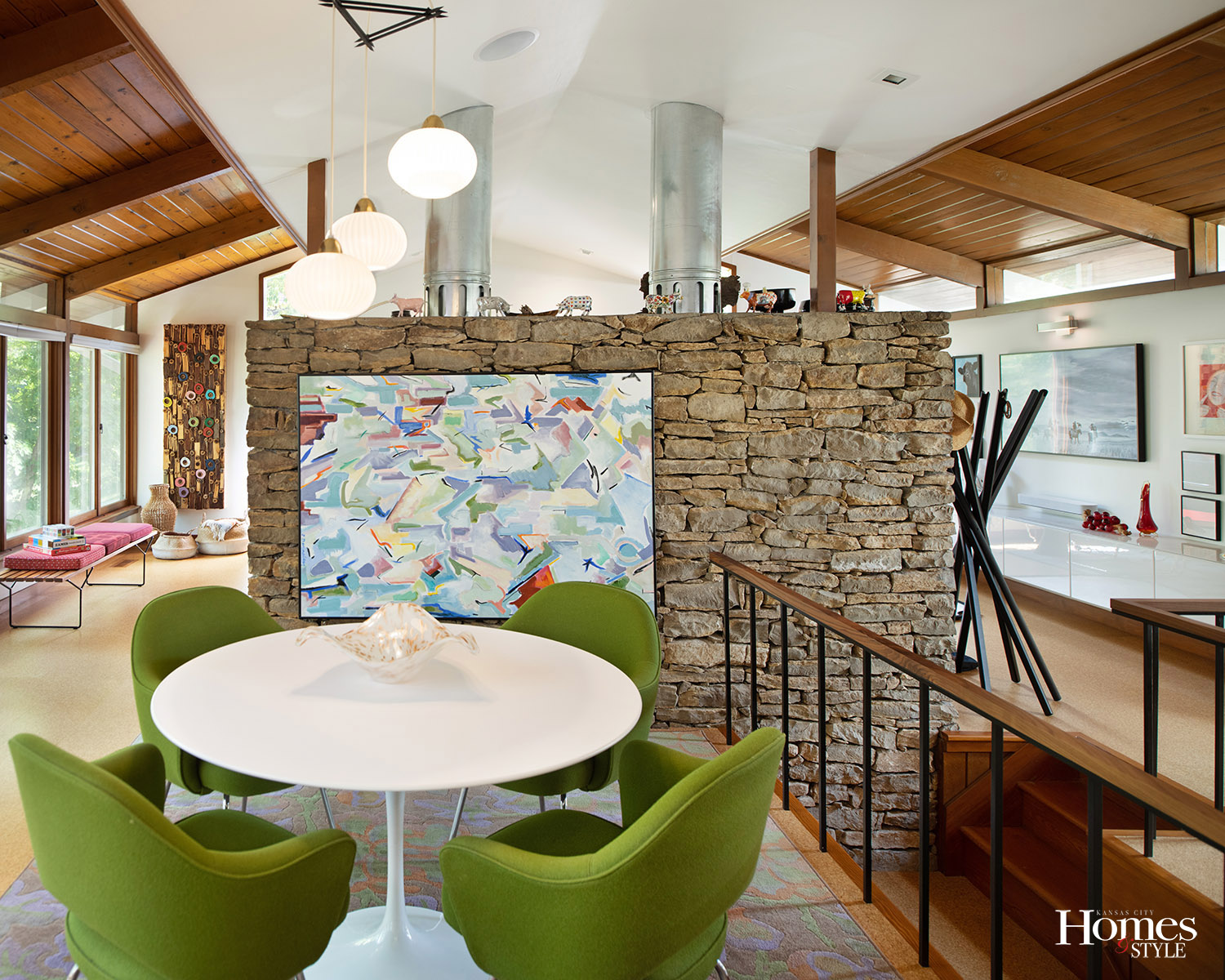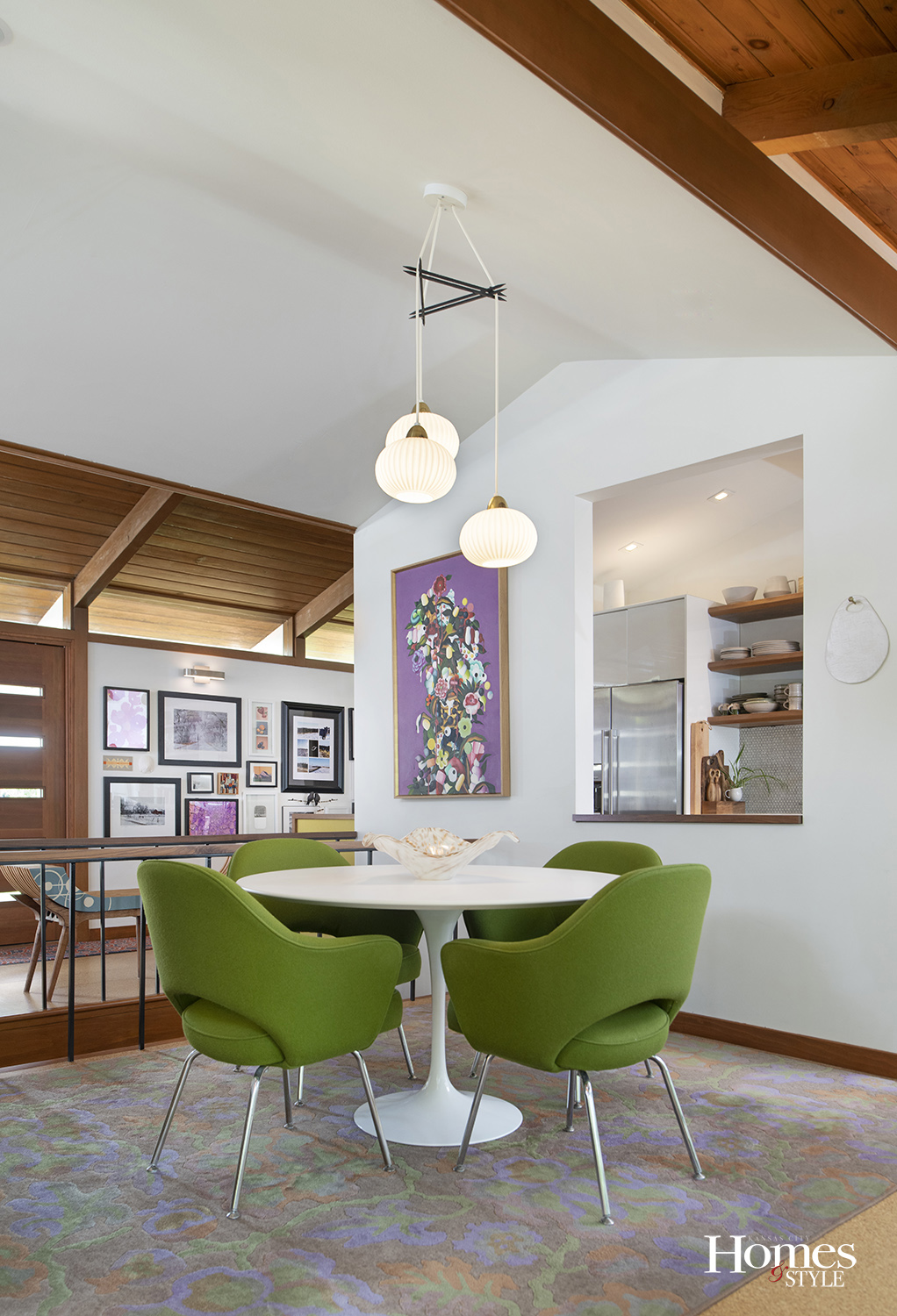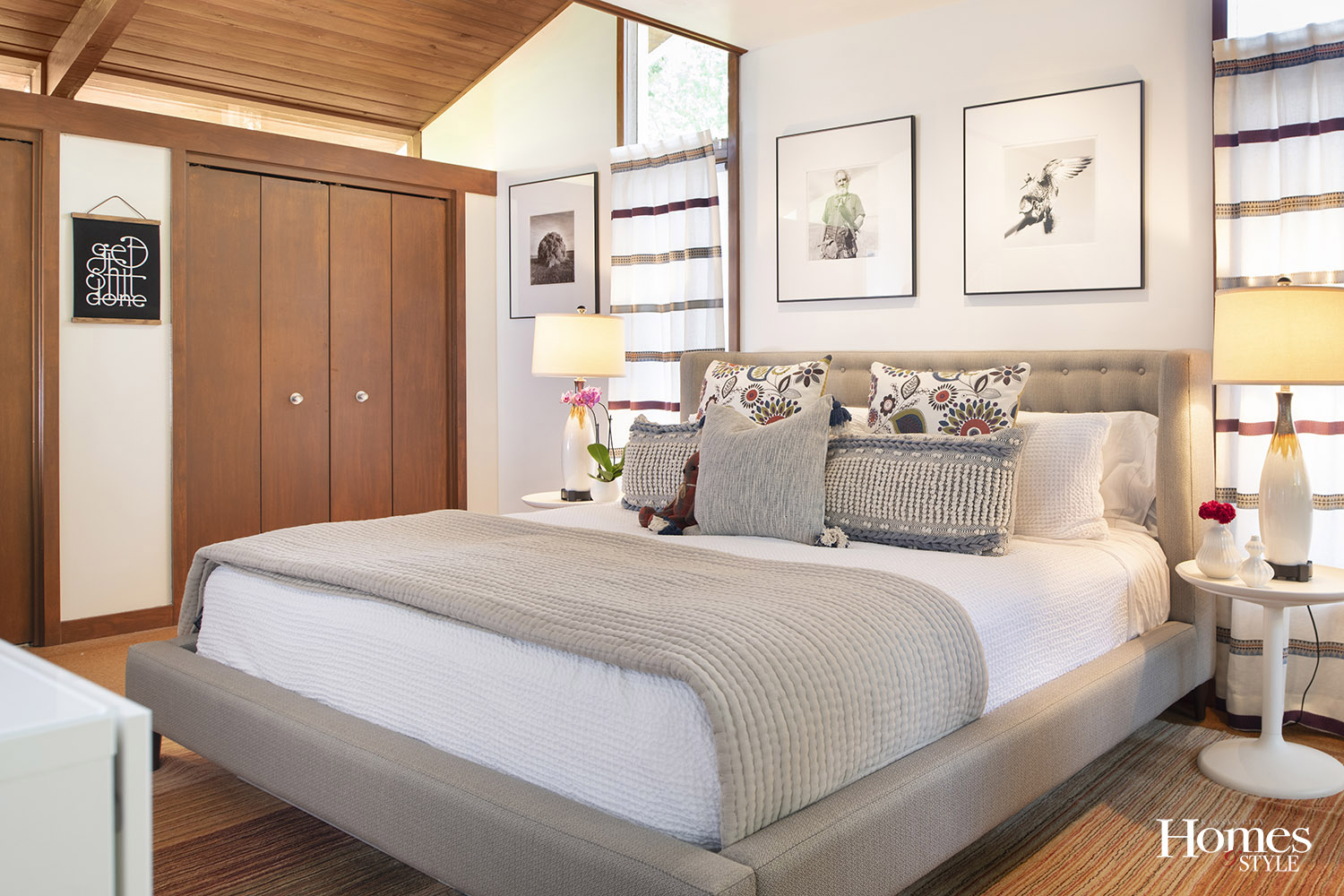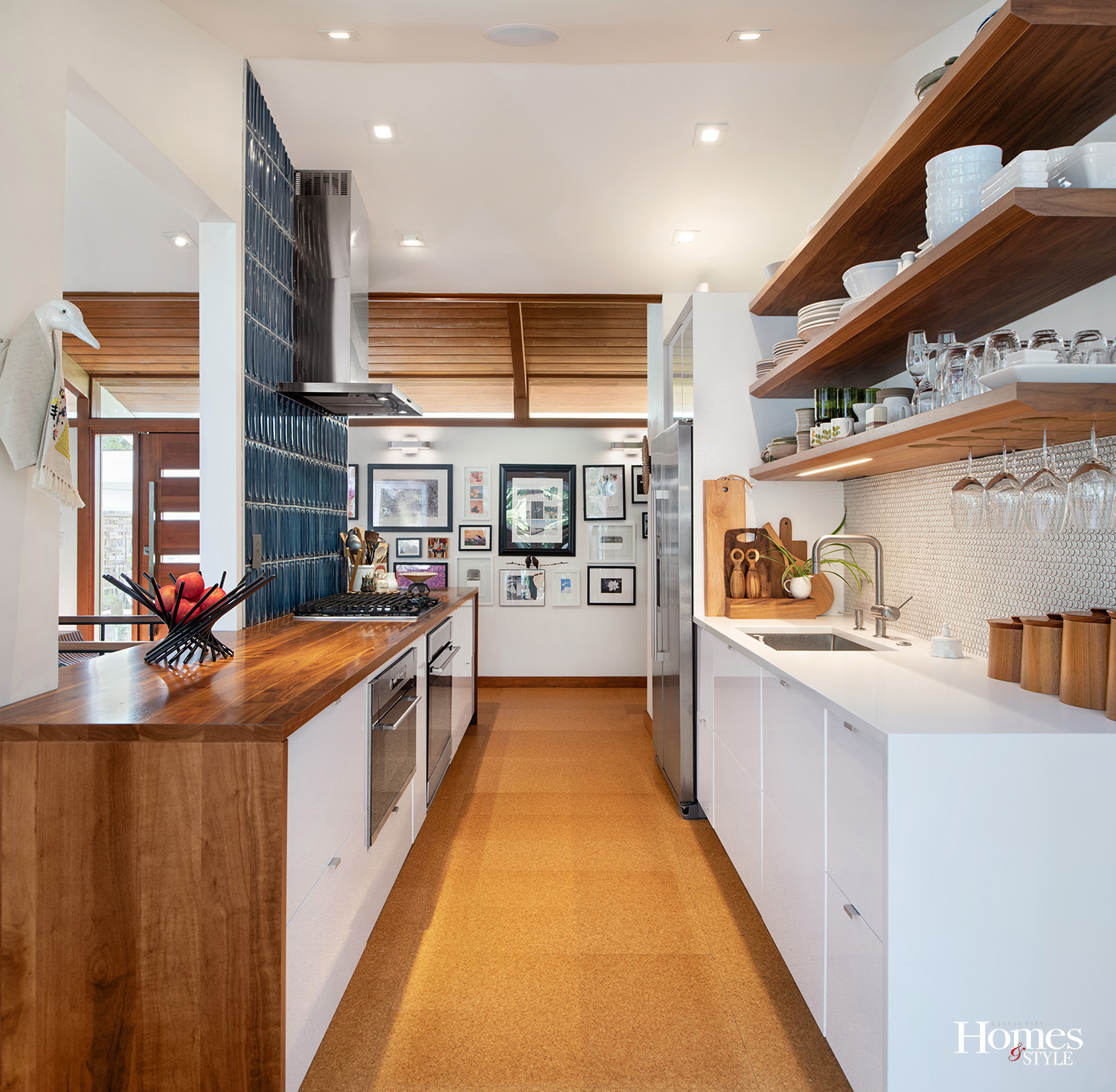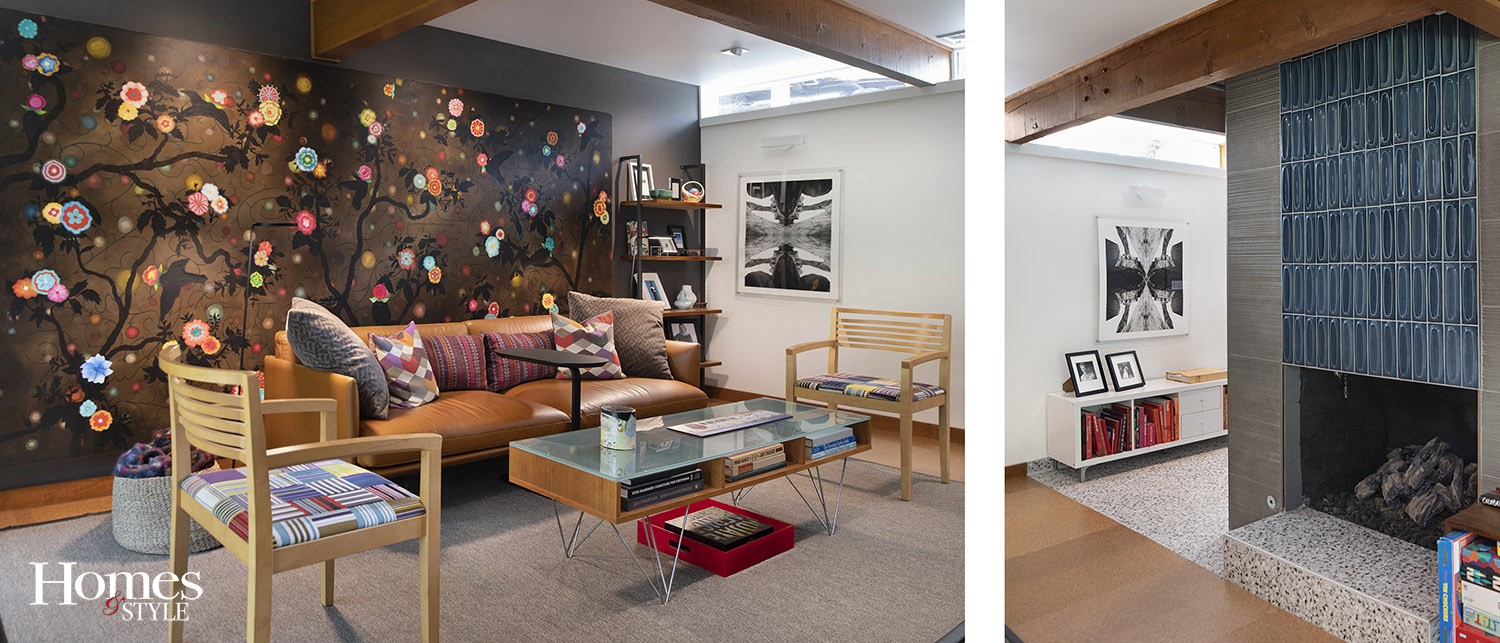This mid-century modern ranch home meets dream lake house with a redesigned open floor plan.
Story by Ann Butenas | Photography by Matt Kocourek
Nestled just below street level in the prestigious City of Lake Quivira, this unassuming home would not necessarily catch your eye at first blush. However, upon further observation, you are drawn into its embrace with each step you take closer to the front door. The courtyard greets you with its ornamental grasses, a delightful sculpture, and a water garden. As you take in all of these elements, you feel a warm welcome greet you on the other side of the front door. Once you cross its threshold through the pivoting front door, you are enveloped in a comforting glow of abundant natural light and colorful artwork, all of which was distinctly curated for the interior of the home.
Built in 1962, this Lake Quivira home was being sold as a teardown and had visible and knowing structural damage. However, those stumbling blocks did not deter current owner Amy Funk from making an offer and purchasing the home in 2017.
“I bought this house knowing I had a project on my hands,” smiled Funk, who previously lived in a mid-century modern ranch home in Prairie Village. In fact, she was enthusiastically up to the challenge.
An interior designer by training, Funk previously worked for architecture firms as a professional Interior Designer. She currently works for KnollTextiles and has been with the company for 21 years. As a result, she has a strong understanding of finishes, trim, flooring, furniture, and the like. So, when it came to redesigning this 2,000 square foot home featuring four bedrooms, two bathrooms and a powder room, Funk was clearly in her element. The first job to tackle was the structural integrity of the home.
“The house was leaning in three inches and the studs were hanging on the back side of the house by a half inch,” noted Funk. “Plus, all of the windows were broken out on the front. We had to gut the house clear to the studs and then we opened it up. We also dug a trench and put in a retaining wall.”
A series of pulley and cables were used to pull the back of the house to the front as part of the post and beam construction. As there was no horizontal support to the roof, Funk had trusses added and raised the roof by three inches.
“The trusses and cables are in the attic now,” she indicated, which was done to maintain the vaulted ceiling and clear story windows. All new plumbing and electric was also incorporated. The bulk of the work took roughly a year to do, allowing Funk to finally move into her new home in 2018.
“I wanted to restore and maintain as much of the original architecture as I could,” she said, emphasizing her attention to detail throughout the entire restoration and redesigning process. Among those detailed and time-honored appointments include the installation of Heath tile (found in the bathrooms, kitchen, laundry room, bar area and around the fireplace), cork floors, Douglas fir trim and modern furniture. Funk also maintained the original handrails (adding one on the opposite side to match), the stone fireplace and the unique clear story windows.
The original fireplace had two clay chimneys which Funk took out and instead installed galvanized metal pipes along with gas fireplace logs. She also had to do some minor repair work to the stone. She left the original wood paneling only in the stairwell, an area she also opened up. An 8’ wide x 8’ tall closet used to stand where the bench near the entryway is now.
The kitchen was formerly enclosed with a door on each side, making it akin to more of a small pass-through.
“The original kitchen was designed more for maids cooking for a party,” commented Funk. “The kitchen also had a pantry, but I removed that and further opened up the space, along with the dining room and then I had the ceiling vaulted.”
For the kitchen design, Funk wanted to tie in knotty pine ceilings. She installed walnut countertops in the prep area by the stove and quartz countertops on the sink side/wet area. She opted for a waterfall edge on the counter at the end of the kitchen to create a nice backdrop, giving the feeling that you are in the entry of a home while simultaneously creating a visual space divider.
The home had five bedrooms when Funk purchased it, but she tore out one of them, enlarging the main suite. She also added a powder room to the left of the entry where the hallway to the other bedroom was.
In the living room is a gallery wall and a floating credenza. To the untrained eye, the built-in furniture looks original, which is what Funk wanted as she stuck to honoring the time period in which the home was built.
A unique feature outside of the home is the deck in the backyard encompassing a tree.
“The house used to have an interior patio, like an alcove that went six feet inside, so I captured that space and pushed it back with a panoramic aluminum door,” she noted. “Before, there were three sliding glass doors setting six feet in. It has a 20 foot opening now.”
Because Funk did not want to lose the grand sycamore tree, she built the deck around it. However, she realizes that as the tree grows, her deck will shrink. She has already had to enlarge the hole that surrounds it since she moved in, but she appreciates the coziness it offers.
“As the deck has to shrink, however, it does make it difficult to plan furniture out here,” she laughed. “It definitely has a tree-house type feeling, though and backs nicely to the woods. This house is on the 14th hole of the golf course, which you can kind of see from here as you peek through the trees, but this space is really more woodsy, which I enjoy.”
The lower level of this reverse ranch home was designed to feel like an integral part of the home. Funk added patio doors to the family room and to the guest room, creating distinct patios for each space, both of which are separated by landscaping and the deck.
“I wanted to create a serene guest room, with a view of the water fountain on the golf course,” expressed Funk, who indicated on the other side is the grill, dining table and entrainment area. A walking path exists between both patios for ease of going back and forth.
The lower level also has terrazzo-like tile with heated floors. An oversized piece of art hangs behind the couch in the family room to create a strong focal point to the space. Also on the lower level is Funk’s textile studio, where she does her professional research, maintains samples and color palettes, and engages in various design projects for clients.
Because the house has all original windows, Funk admits it is not easy to heat and cool, but it was designed to take advantage of the sunrise in the east.
“The house sits at a catty-corner and captures natural light in the back as it was architecturally designed with the sun rising in the East and now windows on the front protects it form the seething sun in the West,” she explained. “The eaves protect the clear story windows so not a lot of hot heat comes through, making it energy efficient.”
While it took some time, a bit of sweat and loads of inspiration, Funk restored this home into a place that beautifully honors its past while happily living in the present moment.
“I am really enjoying it all,” she smiled.
Resources
- Advanced Systems of Northeast KS
- Andersen Windows and Doors
- Arco Floor Lamp
- Barb Gerhardt Upholstery
- Black Bamboo
- California Panoramic Door Co.
- Cambria
- CB2
- Centro Modern Furnishings
- Dave Haggard Construction
- Decolav
- Crate and Barrel
- Family Tree Nursery
- Fortress Railings
- GE
- Grass Pad
- Grohe
- Hansgrohe
- Heath Tile
- House of Rocks
- Ikea Cabinets
- Jason Pollen
- JetAlum
- Jill Kokesh Photography
- Jonathan Adler
- Juno Lighting
- Knotty Rug Co.
- Kohler
- Knoll Studio
- Knoll Textiles
- Max Key Paintings
- MBA
- MBC Construction
- Muuto
- Nebraska Furniture Mart: Sonos/Samsung
- Pacific Mutual Door
- Pivot Door.com
- Rejuvenation
- Samsung
- Sherwin Williams
- Smoke n’ Fire
- Sonoma Tile Co.
- Square One Studio
- Superior Sheet Metal Co. Inc.
- Swanky
- Water’s Edge
- Westport Glass
- Zandur Cork Floors

